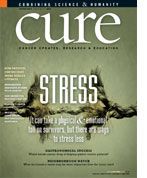Publication
Article
CURE
Gut Reaction
Author(s):
A breast cancer drug delivers a heavy blow to certain stomach cancers.
J.P. Gallagher understands the ins and outs of gastric cancer. He knows how hard it can be to find the right treatment team. He realizes that even the experts can disagree on how and when chemotherapy and radiation are best administered. And he knows what life is like without a stomach.
Gallagher, 40, of Redwood City, California, also remembers how hard it was, after his early-stage diagnosis, to find information that was useful and hopeful amid an online sea of dire data. “For me, having the right mind-set and having a faith and belief that you can be better is so important,” says Gallagher, who underwent surgery followed by chemotherapy and radiation.
Gallagher’s cancer was caught before it spread, but for about one-fifth of people with advanced, inoperable gastric cancers, new scientific data promises to change the treatment landscape.
That data, first presented this summer at the annual meeting of the American Society of Clinical Oncology, involves the targeted treatment Herceptin (trastuzumab), a breast cancer therapy on the market for more than a decade.
The new study found that Herceptin can improve survival among advanced gastric cancer patients whose tumors overproduce human epidermal growth factor receptor 2, or HER2, a sort of “dock” (formally known as growth factor receptor) that sits on the surface of the cancer cells. (An understanding of its role in breast cancer has led scientists to look for HER2 overproduction in other cancers.) Herceptin, which is a biological treatment—meaning it works with the body’s immune system—attaches to those HER2 docks, interfering with chemical traffic that signals the cells to grow.
“For gastric cancer, that’s probably one of the largest differences we’ve seen in overall survival with the addition of just one agent.”
David Ilson, MD, PhD, a medical oncologist at Memorial Sloan-Kettering Cancer Center in New York City, notes that research has been able to make only small inroads toward increasing survival times in advanced gastric cancer.
“I would consider all of these developments a modest improvement,” he says of the Herceptin finding, as well as gains made by modifying chemotherapy regimens. “We have not made the kind of advances we’ve made in colorectal cancer, where combined chemotherapy and targeted agents have doubled the survival.”
Even so, Ilson believes the use of Herceptin, which has become an important treatment for HER2-positive breast cancers, will become widespread against HER2-positive advanced gastric cancers. “I think once the data get out there, it’s going to very quickly become the standard of care.”
A representative of Roche’s Genentech, which makes Herceptin, says the company is discussing with the Food and Drug Administration the possibility of submitting an approval application for the drug as a treatment for advanced HER2-positive gastric cancer. The drug was filed for approval in Europe in September.
Bekaii-Saab says his hospital has begun to screen gastric tumors for HER2 expression, and doctors are beginning to test whether and how insurance covers the medicine. “On the first few patients we’ve had, we haven’t had problems with insurers,” he says. “But of course … this is an expensive drug; you have to make the case.”
Ilson adds that there is active interest in developing trials to test the drug’s effectiveness against earlier-stage HER2-positive tumors, for instance as treatment given at the time of surgery, he says. But Ilson and Bekaii-Saab agree that without data, it’s too early to consider using Herceptin against early-stage tumors, which typically are treated with some combination of surgery, chemotherapy, and/or radiation.
For such early-stage cancers, figuring out the best treatment approach can be complicated. Gallagher was 37, working in high-tech marketing in the San Francisco Bay area, and had two kids—with a third due within six weeks—when his stomach cancer was diagnosed in October 2007.
In the three months prior, he had intentionally dropped 25 pounds from his high weight of 245. But that weight loss, ­combined with a feeling of food getting “stuck” in his chest, prompted his primary care physician to order a barium swallow test—which detected an anomaly. Endoscopy and a biopsy revealed cancer, and a PET scan was ordered.
“I literally zipped up my briefcase … and didn’t go back to work for nine months,” Gallagher says of the day he found out. The PET scan was clean—the cancer, which surgeons later found had begun in the stomach lining and grown up into the esophagus, hadn’t spread.
Gallagher, who founded the Gastric Cancer Fund (www.gastriccancer.org; 919-380-9505), advises other gastric cancer patients to follow the course his wife, Cindy, charted—seek multiple opinions promptly. Given that gastric cancer is relatively rare in the U.S., he also advises finding a center with lots of experience treating this type of tumor.
One of Gallagher’s three opinions came from a Stanford University Medical Center tumor board, a cross-disciplinary panel including experts with oncological, surgical, and radiological expertise. “They said, ‘The great news is it hasn’t spread yet. We’ve seen this before,’ ” he says. Their plan: a complete gastrectomy, with likely removal of part of his esophagus, and aggressive chemotherapy and radiation. One physician on the case “put his arm on my shoulder and said, ‘We can help you.’ That really mattered,” Gallagher says.
That November, his stomach and lower esophagus were removed. The remainder of the esophagus was attached to the intestine, with surgeons crafting a small pouch to serve as a stomach. He also underwent two three-week cycles of combination chemotherapy (Xeloda and carboplatin), then five weeks of radiation along with Xeloda, and a final three-week cycle of Xeloda and carboplatin.
Having surgery first, then postoperative chemotherapy and radiation, is typical in the U.S., Ilson says. But British data suggest that using pre- and postoperative chemotherapy without radiation achieves similar survival rates. “That’s a major controversy,” he says. Studies are under way to address the issue.
Meanwhile, by April 2008, Gallagher couldn’t proceed with chemotherapy due to diminished white cell and platelet counts. At that point, “everything felt raw in my GI tract,” he says.
It was a struggle to eat again, but Gallagher now says he has about five small meals a day. He focuses on staying hydrated, and relies on nutritional support—including multivitamins, vitamin D supplements, and monthly B-12 shots—to ensure his body meets its daily needs. He doesn’t mix food and beverages, lest he cause dumping syndrome, where food slides through him without being absorbed. He avoids red meat and alcohol, limits caffeine and spicy food, and struggles with dairy foods.
For a while, Gallagher says, his weight seemed stuck around 154 but finally bounced up to 175. He returned to work last June but still experiences fatigue. “To this day, it’s still kind of getting back to where I was before,” he says.
“It’s an exciting time in gastric cancer—once a disease that had poor outcomes across the spectrum. We now have many options in development.”
At 37, Gallagher was a little over half the median age (71) of U.S. gastric cancer patients at diagnosis. Although the disease is a leading cause of cancer deaths worldwide, particularly in Korea and Japan, it is much less common in the U.S., where in 2009 it’s expected to be diagnosed in about 21,000 people and kill more than 10,000.
The U.S. figures have plummeted since the 1930s. Experts suggest refrigeration—with the accompanying increase in availability of fresh produce, and a reduction in smoked and salt-preserved foods—may be one explanation. Another may be the widespread use of antibiotics, which kill or tame the ulcer-causing bacteria Helicobacter pylori, whose presence increases risk for stomach cancer. However, while gastric cancers are becoming less common in America, cancers of the gastroesophageal junction are increasing, possibly due to a rising incidence of obesity, gastroesophageal reflux disease, and a condition related to reflux known as Barrett’s esophagus.
Even as gastric cancer has declined overall in the U.S., continued development of targeted biological treatments remains a priority. Besides Herceptin, a variety of such agents are in late clinical testing. For instance, Tykerb (lapatinib), another medicine that inhibits HER2, is being studied in combination with chemotherapy against metastatic gastric cancers that are HER2-positive.ther biological agents—targeting different mechanisms, or pathways, that help cancer grow—are under scrutiny. Among those being tested extensively in gastric cancer are the colon cancer drugs Vectibix (panitumumab) and Erbitux (cetuximab), which is also used to treat head and neck cancers. Phase 3 studies of the drugs, which target a pathway known as epidermal growth factor receptor, are under way.
He also thinks a pathway called VEGF, short for vascular endothelial growth factor, looks particularly promising, with a drug that targets it, Avastin (bevacizumab), already making an impact in metastatic breast, colon, and kidney cancers as well as in lung cancer and glioblastoma. Phase 2 studies of Avastin, along with chemotherapy, for advanced gastric cancer have yielded survival times of up to 16 months, Bekaii-Saab says. In addition, the drug is being tested in earlier-stage patients treated surgically. “There will be a lot of Avastin data in the next couple of years relating to gastric cancer,” he says.
And still other possible biological agents are in even earlier stages of development. “It’s an exciting time in gastric cancer—once a disease that had poor outcomes across the spectrum,” Bekaii-Saab says. “We now have many options in development.”
View Illustration: New Mode of Attack
In a phase 3 international trial called ToGA, researchers screened about 3,800 patients, mostly from Asia or Europe, who had advanced gastric or gastroesophageal adenocarcinomas. Among the 22 percent of them whose tumors overproduced HER2, almost 600 patients received a chemotherapy regimen of Xeloda (capecitabine) or 5-fluorouracil, plus cisplatin. About half were also given Herceptin. In patients who received Herceptin, median overall survival time was 13.8 months (meaning that half the patients survived longer, half shorter), compared with 11.1 months in the group that received chemotherapy alone. For patients with the highest levels of HER2, median survival reached 16 months.
“For gastric cancer, that’s probably one of the largest differences we’ve seen in overall survival with the addition of just one agent,” says Tanios Bekaii-Saab, MD, director of gastrointestinal malignancies at the James Cancer Hospital at Ohio State University in Columbus. “For about one out of five patients with advanced gastric cancer, we’re going to have an added agent that significantly improves their outcome.”
Improvement with Herceptin was seen among those with both stomach and gastroesophageal junction cancers. Side effects, including low blood counts and vomiting, were similar between the two arms, with no increased risk of heart damage, an effect associated with Herceptin.
Researcher Eric Van Cutsem, MD, PhD, noted in presenting the study at ASCO’s annual meeting that there’s an unmet need for options in advanced gastric cancer. “It’s a fair conclusion to say [Herceptin] is the first biological to show a survival benefit in patients with advanced gastric cancer,” said Van Cutsem, of University Hospital Gasthuisberg in Leuven, Belgium. “And [Herceptin] in combination with chemotherapy is therefore a new treatment option for patients with HER2-positive advanced gastric adenocarcinoma.”





